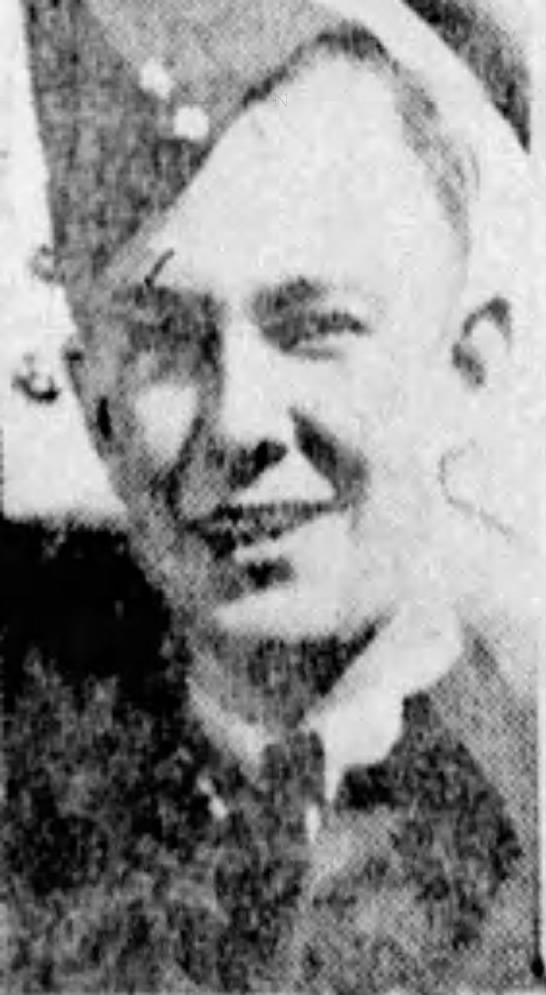
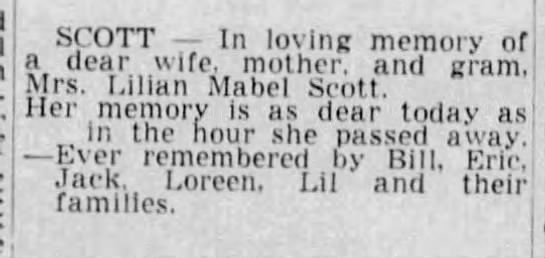
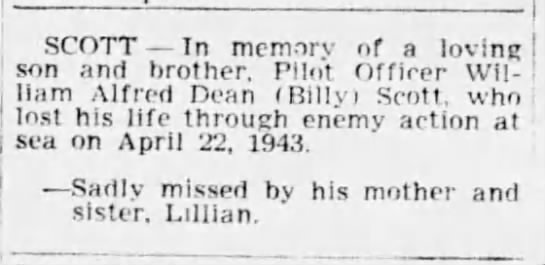

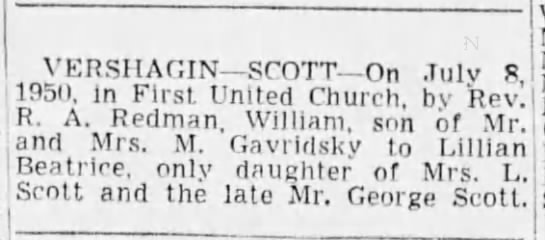

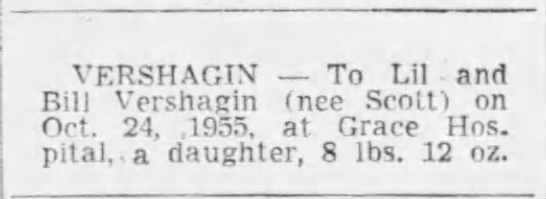
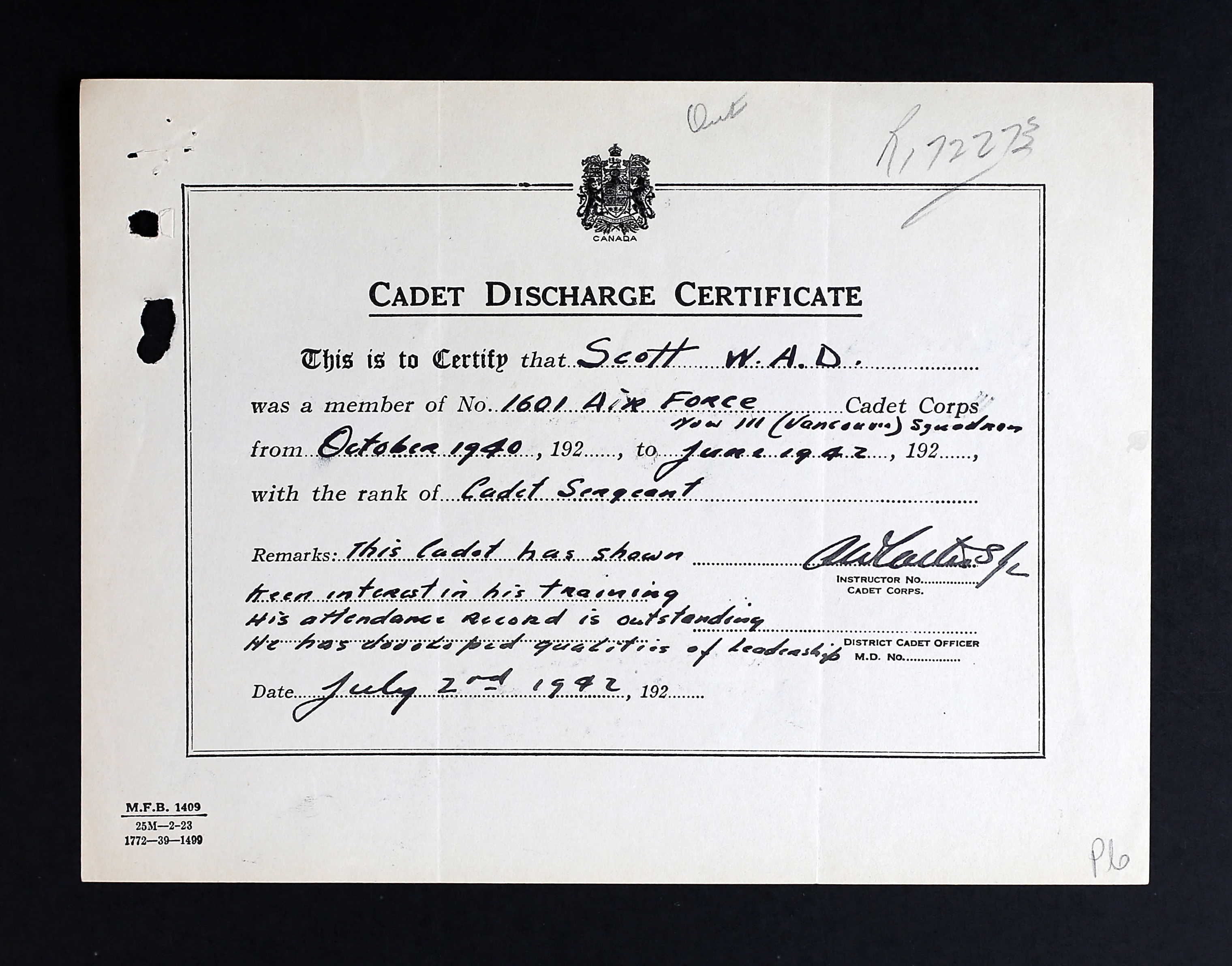
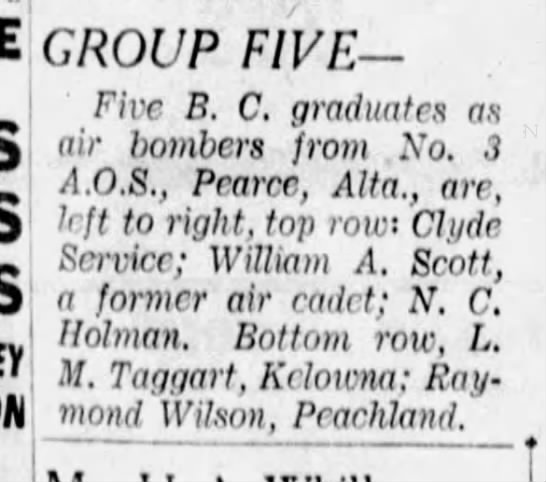
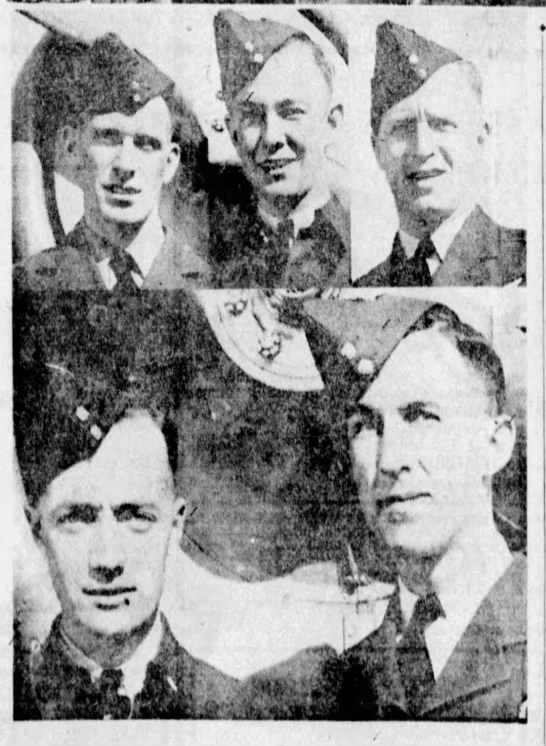
June 4, 1924 - April 22, 1943










William Alfred Dean Scott was the son of George Nichol Scott (1879-1937) and his wife Lilian Scott, of Vancouver. He had one younger sister, Lillian. The family was Anglican.
Billy, as he was known to his family, had a Grade XI education from Kitsilano High School, where he achieved an A in math. “He was popular and reliable, and a good student of the school.”
He signed his forms, Alfred. He was a student, but also worked as a helper to Mr. Kelly Douglas at the time of his enlistment in Vancouver on August 23, 1942. He noted that he fractured his left wrist at the age of 10. He liked rugby, soccer, swimming, and baseball. His physique was noted as athletic and his mentality: alert. He had a mole on his left knee. “A stable intelligent young lad with excellent, who unfortunately, is unfit for pilot because of ocular muscle imbalance. Good observer material.” Alfred had been with the 1601 Air Cadets from 1940 to 1942.
Alfred stood 5’10” tall and weighed 147 pounds. He had brown eyes and light brown hair. He had a medium complexion. “Education and C.T. very satisfactory. Young, alert lad who has just completed Jr. Matric and is eager to get into training.”
He was sent to No. 3 Manning Depot, Edmonton from June 23, 1942 until August 1, 1942. Then he was sent to No. 1 SFTS, Claresholm, Alberta, then to No. 11 E. D. in Calgary until a space opened up for him to start at an ITS.
On September 13, 1942, he returned to Edmonton to No. 4 ITS until November 21, 1942.
Alfred was at Mossbank, Saskatchewan, No. 2 B&G School, Course 68, November 23, 1942 until February 20, 1943. “Winter flying conditions make the assessment a poor indication of the student’s ability. His bombing work is average. Academically above average. Young and industrious. Should be a good bomb aimer.” He was 8th out of 33 in his class with a 66.8%.
Then he was sent to No. 3 AOS, Pearce, Alberta February 12, 1943 until April 3, 1943. Alfred was awarded his Air Bomber’s Badge on March 19, 1943 and his commission on the same day.
Alfred traveled across the country to Halifax and was taken on strength at the Y Depot April 4, 1943. By April 14th, he was attached to the RAF Trainees’ Pool, awaiting transportation overseas.
On April 22, 1943, Alfred was aboard the Amerika, British Motor merchant ship. It was on its way from Halifax, Nova Scotia to Liverpool. It was torpedoed as the ship was heading to Britain. It was a straggler in convoy HX-234. Thirty-seven men, all officers in the RCAF, were presumed missing as a result of enemy action at sea; sixteen were landed at a British port after their ship was sunk by U-306, south of Cape Farewell, off Greenland. Forty-two crew members and seven gunners were also amongst those who were lost. The master, Christian Nielsen, 29 crewmembers, eight gunners, and sixteen passengers were picked up by the HMS Asphodel, and landed at Greenock. General cargo, including metal, flour, meat and 200 bags of mail were also lost.
In late June 1943, Mrs. Scott received a letter from F/L Gunn, RCAF Casualties Officer, for Chief of the Air Staff: "Since my letter of May 6th, no additional news has been received. Attached is a list of the names and next-of-kin of sixteen Royal Canadian Air Force officers who embarked on the same ship as your son and following enemy action at sea were safely landed in the United Kingdom. The following official statement was made in the House of Commons....’I have been in receipt of communications from a number of members of this house and from people outside with reference to rumours regarding the recent loss of a number of members of the RCAF by the sinking of a ship in the north Atlantic and I desire to make the following statement on the facts. The vessel in question was a ship of British registry of 8,862 tons, designed for peace-time carriage of both passengers and freight, and having a speed of fifteen knots. She carried a crew of 86 and the passenger accommodation consisted of 12 two-berth rooms with bath and 29 other berths, providing cabin accommodations for 53 passengers. She was fitted with lifeboat capacity for 231 and travelled in naval convoy. Under the recently revised regulations agreed to by the United States authorities, the joint United Kingdom and United States shipping board, the Admiralty, the Air Ministry and the Canadian authorities, a vessel of this description travelling in convoy is permitted to embark as crew and passengers a maximum of 75% of the lifeboat capacity. The lifeboat capacity as stated above was 231, 75% of which is 173. Personnel on board consisted of the crew of 86, and RCAF personnel numbering 53, a total of 139, well within the prescribed limits. Because of the superior type of available passenger accommodation, the speed of the ship and the provision of naval convoy, the offer of the entire available space to the RCAF was immediately accepted. Rumours to the effect that this was a slow freighter not suitable for passenger accommodation are, of course, not in accord with the facts. Every precaution was taken to safeguard the lives of these gallant young men. It should be pointed out that on account of the serious shipping shortage every available berth on such ships must be used, and had the space not been taken up by the RCAF officers of the other arms of the services would have been placed on Board. It should also be stated again that the submarine is still the enemy’s most powerful weapon and that the Battle of the Atlantic is not yet won. Any ocean trip today in any part of the world is fraught with danger and I think I ay safely say that our record in transporting our soldiers and airmen to the United Kingdom is one of while we may all be proud. No one deplores more than I do the loss of 37 of the finest of our young men who gave their lives for their country as surely as if they had done so in actual combat with the enemy, and I extend my deepest sympathy to their loved ones in their bereavement.’ If further information becomes available, you are to be reassured it will be communicated to you at once. May I again extend to you my sincere sympathy in this time of great anxiety."
In January 1944, Mrs. Scott received a letter from Air Marshall Robert Leckie informing her that Alfred was now officially presumed to have died on Active Service on April 22, 1943.
A letter was found in Alfred’s file dated February 10, 1946 to Mr. Howard Green, MP for the riding of Vancouver Quadra: “This officer was proceeding Overseas by ship when the ship was torpedoed in mid-Atlantic on April 22, 1943. He and 36 other RCAF personnel lost their lives. All possible information was conveyed to the next-of-kin including the names and next of kin of 16 personnel of this Service who were rescued. Also they were conveyed in full the statement of the Honourable the Minister of National Defence for Air, made in the House of Commons.” The writer provided the report to the MP as Mr. Green’s query was general in nature and not a specific request.
In October 1955, Mrs. Scott received a letter from W/C Gunn stating since that Alfred had no known grave, his name would appear on the Ottawa Memorial.
Alfred’s mother and sister placed an ‘in memoriam’ in the paper in 1944. Here they referred to him as Billy.
His sister married in 1950 and had a son and a daughter. Mrs. Scott passed away in 1964.